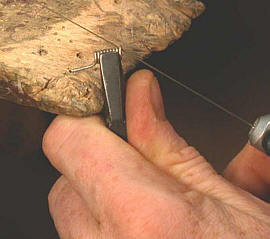Cutting Jump Rings
Once you've wound jump rings around a mandrel, what's the best way to cut them apart? Some craftspeople use hand-held side cutters, but there is one problem with this method - it cuts only one side of the wire flush. Therefore, you have to cut the ring twice, which results in a small amount of waste and slightly varying ring diameters.
2 Minute Read
Once you've wound jump rings around a mandrel, what's the best way to cut them apart? Some craftspeople use hand-held side cutters, but there is one problem with this method - it cuts only one side of the wire flush. Therefore, you have to cut the ring twice, which results in a small amount of waste and slightly varying ring diameters.
As an alternative, working goldsmiths tend to use other cutting tools. Some use separating discs, but these cut ragged edges and tend to create a lot of heat. A superfine separating disc works better, but it is hard to have complete control over the procedure. As a result, most goldsmiths use jewelers' saws, which are slower and more controllable.
| Photo by Charles Lewton-Brain |
In addition to a jeweler's saw, there are a number of tools and methods you can use to cut jump rings, including the following.
When I make jump rings, I wind a short section at a time and saw off the rings by hand, using the bench pin for support. If the section is long and a little wobbly, I hold it as shown on the left of figure 1; if it's short and stiff enough, I hold it as shown on the right. In both cases, the coiled rings catch onto the little wooden nub that I shaped into the bench pin.
In addition to holding the coil in your hand, you can use a pair of self-locking pliers. I filed a rounded groove into each side of the jaws. The jump ring coil fits in the grooves, allowing you to hold it securely while cutting.
Carol Campbell of Kingston , Jamaica , wraps tape around the outside of wound jump rings to keep them together during cutting. (I like them to fall out of the way as I cut them loose.)
Tammy Powley offers a tip on cutting jump rings in her online newsletter, Jewelry Making : "After coiling wire around a mandrel, thread your saw blade through the coil to cut the jump rings apart, and saw from the inside out. This makes sawing the coil easier, as your blade tends to slip when starting to cut from the outside of the coil." (She uses a Jiffy Jump Ring Tool to hold the jump ring coil steady while cutting it from the inside.)
There are several tools designed for cutting piles of jump rings. The Jump Ringer and the Koil Cutter by Dave Arens of Tucson are systems designed for the mass production of jump rings. Both use a flex-shaft attachment to create a contained circular saw blade. Clamped jump rings on mandrels are fed onto the tools for cutting.
I learned an old-fashioned method of cutting jump rings en masse from Christian Gaudernak of Søn , Norway . Take a round steel rod and saw a thin slit into the end (figure 2). Solder a razor blade or matte knife blade so it protrudes 1 to 2 mm from the surface of the rod. Grind off any excess material from the blade. Position a draw plate so it is backwards to how you would normally use it. Pull the rod with the wound jump ring coil on it through a draw plate hole of corresponding size. The draw plate presses the wound rings onto the blade, which cuts them.
The award-winning Journal is published monthly by MJSA, the trade association for professional jewelry makers, designers, and related suppliers. It offers design ideas, fabrication and production techniques, bench tips, business and marketing insights, and trend and technology updates—the information crucial for business success. “More than other publications, MJSA Journal is oriented toward people like me: those trying to earn a living by designing and making jewelry,” says Jim Binnion of James Binnion Metal Arts.
Click here to read our latest articles
Click here to get a FREE four-month trial subscription.
You assume all responsibility and risk for the use of the safety resources available on or through this web page. The International Gem Society LLC does not assume any liability for the materials, information and opinions provided on, or available through, this web page. No advice or information provided by this website shall create any warranty. Reliance on such advice, information or the content of this web page is solely at your own risk, including without limitation any safety guidelines, resources or precautions, or any other information related to safety that may be available on or through this web page. The International Gem Society LLC disclaims any liability for injury, death or damages resulting from the use thereof.
Charles Lewton-Brain
Master goldsmith Charles Lewton-Brain trained, studied and worked in Germany, Canada and the United States to learn the skills he uses. Charles Lewton-Brain is one of the original creators of Ganoksin.
The All-In-One Jewelry Making Solution At Your Fingertips
When you join the Ganoksin community, you get the tools you need to take your work to the next level.
Trusted Jewelry Making Information & Techniques
Sign up to receive the latest articles, techniques, and inspirations with our free newsletter.
